| 1 | Egypt’s ubiquitous cobra |
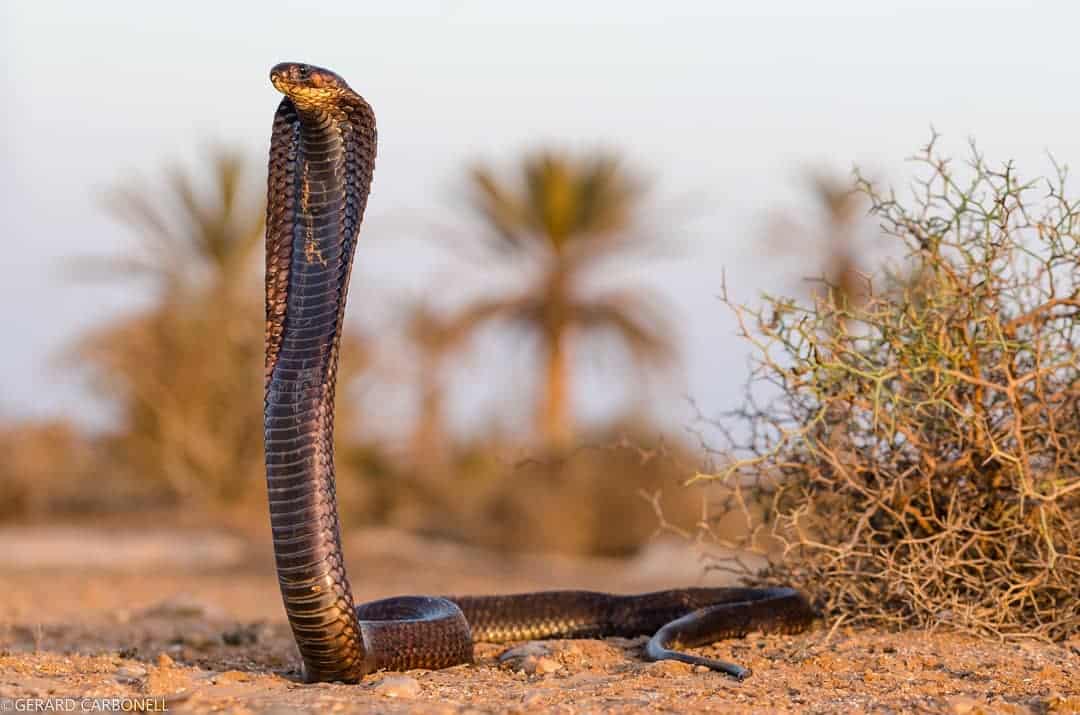
There are some snakes which have escaped humanity’s notice until just recently, being discovered in obscure rainforest muds, such as Zugs’ odd-scaled snake. However, there are others whose story stretches back not just centuries, but thousands of years, into the legendary chapters of the golden past where the very concepts of civilisation were first forged. We’re talking about the Egyptian cobra, which inhabits North Africa, including Egypt, Libya, Morocco, Tunisia and Algeria.
Egyptian cobras are a large species with an all time record of 2.59 metres, and an average adult length of 1.4 metres. They’re one of the darker species, ranging from brown to nearly black, and those in Morocco are particularly black. Their bellies are a lighter cream, while their eyes are smallish, black and beady.
Egyptians call them the asp, and instead of true deserts, they prefer to inhabit savannahs, dry grasslands, semi-deserts and steppes. Their lairs include rock crevices, animal burrows, and old termite mounds. Egyptian cobras are nocturnal, and also known to invade homes, to the terror or maybe delight of occupants, some of whom believe they bring messages.
| 2 | Targets chest, hands and face |
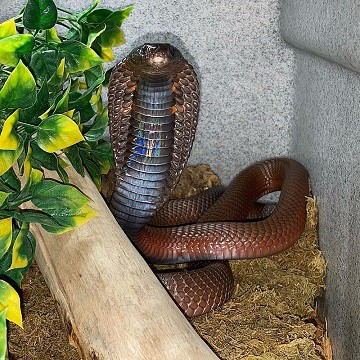
Mankind and the Egyptian cobra have been interacting since 3000BC, dodging past each other while showing a healthy respect, amidst a backdrop of pyramids and sand. Today, they still bite legions of people per year. The venom’s LD50 toxicity rating is 0.19mg, beating the Indian cobra (0.28mg) for potency, but not the black mamba (0.05mg). The venom yield is very high, at 150-300mg per bite.
There’s some nasty abilities, as one study found that a bradykinin-potentiating peptide decreased the heart’s atrial constriction rate in rats. Naja haje venom wreaks particular havoc on the liver, and in rats, “All organs were deteriorated by the cobra venom”. Neurotoxic dangers are secondary with this cobra, but bites can cause ptosis (eyelid drooping), drooling and limb weakness.
The Egyptian cobra’s venom causes a massive increase in free radicals, depleting the body’s innate antioxidants such as glutathione, superoxide dismutase and catalase. The main local effects are extreme swelling and blistering. Necrosis and rotting skin happens, but is less severe than other African snakes like the puff adder. While Egyptian cobra bites don’t have a particularly high fatality rate, a bite requires immediate hospitalisation.
| 3 | Diet: devours almost anything |
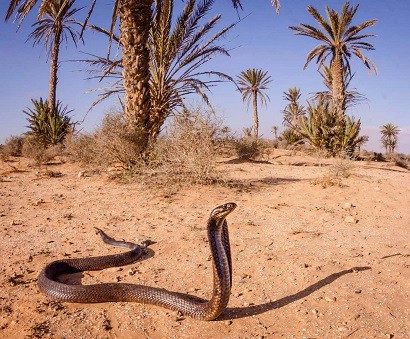
The Egyptian cobra will eat pretty much anything, from guinea pigs to toads to fish. Some believe that they favour toads, while breeders have found that they thrive on rats. The Egyptian cobra is probably a generalist predator. They’re an active hunter, which seeks out their prey rather than waiting around. They sometimes invade villages in search of domestic fowl and chickens.
Egyptian cobras have a no holds barred attitude in general. A study compared their hunting style to the cottonmouth, which was cautious, and only struck mice from a certain coil position. The Egyptian cobra just slithered up to mice and grabbed them, only releasing if the mouse painfully bit them. Another part of their diet may be other snakes, as the Egyptian cobra has been spotted twice hunting or about to eat the Saharan horned viper.
As cobras go, the Egyptian cobra isn’t ultra aggressive, but nor are they shy. Their preferred option is to flee, but if this is impossible, they’ll stand their ground and raise their body, hissing loudly. They don’t hesitate to strike if their warnings are ignored.
| 4 | Secrets of the past |
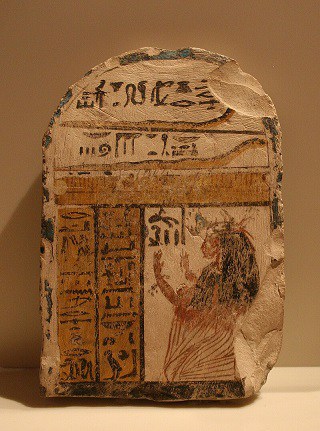
The Egyptian cobra is a snake species that plays dead, particularly when confronted with the fearless Egyptian mongoose. They’re also excellent swimmers, and have been spotted swimming in the Mediterranean sea. They lay 8 to 33 eggs, and the hatchlings are born at 20-30cm long, which is the adult length of a US sharp-tailed snake. While Egyptian cobras aren’t endangered, they’re declining in Egypt, and their skins are prized trophies which can fetch $200.
A brief stroll through any museum will reveal that in Ancient Egypt, symbols of the cobra were everywhere. The pharaohs were so obsessed with Egyptian cobras that some requested that one be mummified with them. One figure was the goddess Wadjet, half woman, half cobra. She was said to watch over the pharaohs, and spit venom at anyone who dared to enter their tombs. Wadjet was represented by the Uraeus, the cobra symbol which appears all over Egypt. The Uraeus can be found in furniture, tomb walls, pottery, and ancient treasure. Pharaohs wore the Uraeus in their crowns of headdresses, to prove their rightful and divine leadership of Egypt.
| 5 | The cruel cobra goddess |
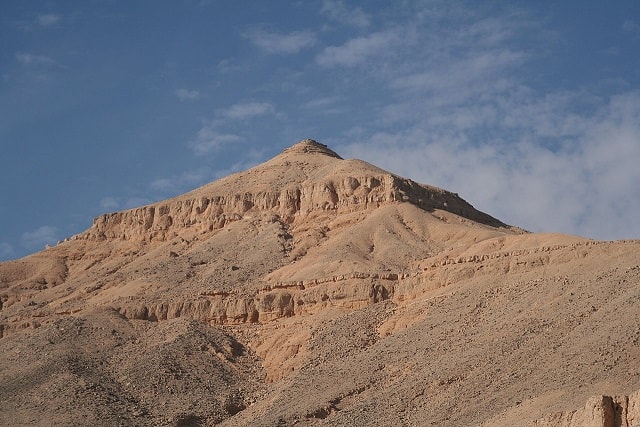
However, Wadjet had nothing on the goddess Meretseger. Forget half-woman; this goddess was (and maybe still is) full cobra, and the Theban Valley’s guardian of the dead. These tombs were packed with priceless, glittering treasures. If thieves succumbed to the temptation to plunder them, then Meretseger would curse them with blindness. Theban and other dead valleys were hot places, crawling with venomous snakes and scorpions. Meretseger was believed to control these demonic creatures, and those seeking safe passage would prey to her. Many shrines and chapels were cut into the sides of these valleys.
Paintings of Meretseger appear in many artefacts. Occasionally she was depicted as part scorpion, but she was normally either a full cobra, a cobra with a woman’s head, or a woman with a cobra’s head. Her name translated to “she who loves silence”.
On the west bank of Luxor in upper Egypt lies a hill called el Qurn, “The Horn”. This small peak was said to be the goddess Meretseger’s home, and home to the Duat, entrance to the Egyptian underworld. This too was said to be slithering with venomous cobras. The proof of these theories? At the very summit of el Quar is a rock formation, a few meters high, which clearly resembles the spread hood of a cobra.
| 6 | Unearthed in ancient tombs |
In 2020, archaeologists announced the discovery of a tomb dating back 2000 years. Using digital scanning, they were now able to peer inside mummified objects without breaking their delicate bandages. One showed a kitten’s skull, while the second was a juvenile Egyptian cobra, which had a severed spine like it had been whipped. It also showed signs of kidney damage, like it had been ritually starved of water. The cobra had hardened resin in its mouth, perhaps part of another mysterious ritual.
Alongside the Saharan horned viper, this species was a candidate in the suicide of Cleopatra in 30BC. Despite her stunning looks, Cleopatra was a poison expert, and performed grisly experiments on snake prisoners. Supposedly, she deemed that Egyptian cobra (aspis) venom was the most painless way to die, and smuggled the snake in with a fig basket. Historians doubt this, as Naja haje causes noticeable skin blistering and necrosis, which was never mentioned when guards found her dead in her bed.
| 7 | Tut’s cobra curse |
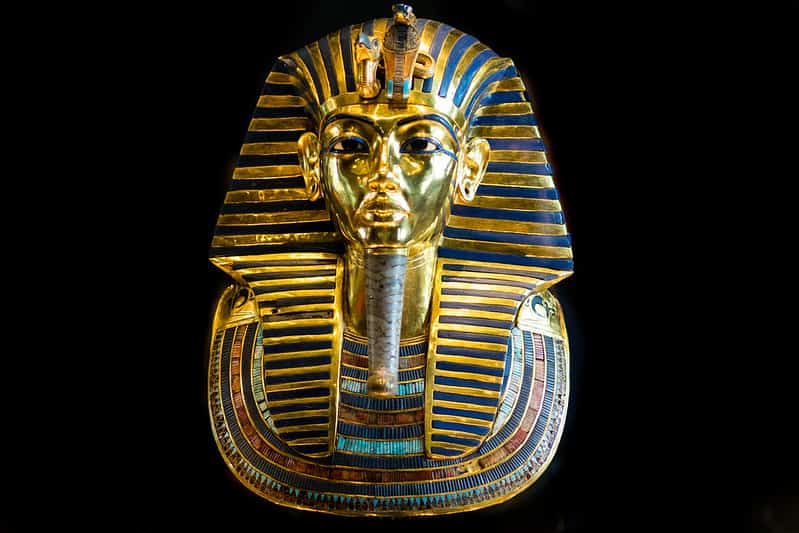
King Tutankhamun himself was one of the pharaohs discovered with a cobra symbol, in the famous discovery of his tomb. The final excavation happened on February 12th 1924, after two years of work.
The burial chamber was decorated with paintings and sculptures, at the centre of which was a sarcophagus made from pink quartzite. Surrounded by dignitaries and VIPS, Howard Carter cranked open a 2500 stone lid using an elaborate pully. They were astonished at what they saw: a 7 foot figure of solid gold. The king’s arms were folded, adorned with olives and faint blue petals. On Tut’s forehead were the twin figures of a vulture and an Egyptian cobra, said to represent upper and lower Egypt respectively. The king’s adorned state was said to represent his immortality and eternal youth in the afterlife.
News of Tutankhamun’s discovery spread across the world, but later came whispers of a curse. While excavating, Carter had kept a pet canary for company, which constantly sang a happy song. On the day the tomb’s entrance was cracked open, an Egyptian cobra slithered into his house and swallowed the canary whole. Excavator Lord Carnarvon had earlier died after shaving the top off a mosquito bite and developing blood poisoning.
| 8 | A staple of snake charming |
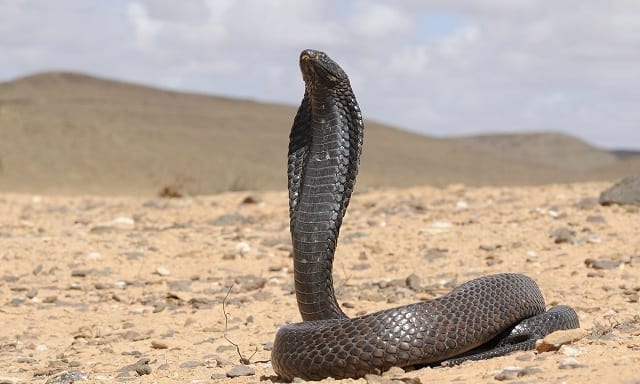
On the white streets of Cairo, the Egyptian cobra is one of the most popular species used by traditional snake charmers. The more dangerous the snake, the more impressive the show, and the Egyptian cobra definitely qualities. The charmers play entrancing music and sway in a hypnotic manner, to “control” the snake in front of a financially generous audience.
Apparently, these charmers have a weird secret, that hijacks the species’ biology. When you apply pressure behind an Egyptian cobra’s neck, the snake becomes stiff and immobile for a while.
The charmers of Ancient Egypt also had responsibilities, like treating snakebite victims, and performing research into the various species. Entertainment was a side gig. These days, it’s more barbaric, as Egyptian cobras have their fangs ripped out and their mouths sewn shut. The snakes often suffer a slow painful death from starvation. Marrakech in Morocco is another snake charming hub, and here they train the cobras to associate a flute’s song with food. Alongside Egyptian cobras, puff adders and Montpellier snakes are also popular here.
| 9 | A particularly paranoid cobra |
One experiment from 2002 illustrated the paranoid nature of the Egyptian cobra clearly. It was a study trying to create a new way to feed venomous snakes, a special two-sided gate with a sort of airlock in the middle (with a patent). The inner gate was still controllable via a hoop. A black mamba took some getting used to the gate, but did eventually. Its feeding time decreased over the weeks when a mouse was offered, and it wasn’t aggressive. The Indian cobras were highly aggressive, and charged towards the gate when their keepers touched any part of it. They too became quicker and quicker at eating the mice.
The Egyptian cobra, meanwhile, was just paranoid. When a keeper approached, it would flare its hood and raise its body up. It would maintain unbreaking eye contact, sometimes being so focussed that they couldn’t feed it. It wouldn’t leave its paranoid defensive position to grab the mouse from the airlock gate, until the keeper walked away. Once they learnt not to distract the Egyptian cobra, it eventually ate the mice.
| 10 | Divided into several subspecies |
The Egyptian cobra once covered a larger area, but has been split into multiple species since the turn of the century. For example, those in Saudi Arabia and Yemen were always a separate subspecies: Naja haje arabica. In 2009, they were elevated to a full species. Southeast Africa hosts the former banded Egyptian cobra, which is now a full species with the name of snouted cobra (Naja annulifera). It’s not surprising, as this is miles away from the main territory.
Those in southwest Africa have been reassigned to the Angolan cobra species (Naja anchietae), and a chunk in west Africa are now Naja senegalensis. All in all, four new species have sprung from the Egyptian cobra recently, so its range has shrunk significantly. Nowadays, the southernmost extent of its range lies in Tanzania.
Unlike some Asian cobras, the Egyptian cobra lacks a marking on the back of its head. The Indian cobra has a large dot, while the Chinese cobra’s looks like a bat.
